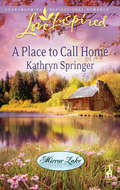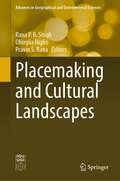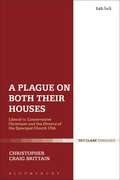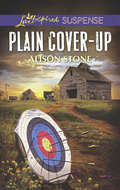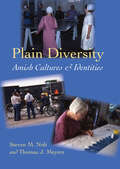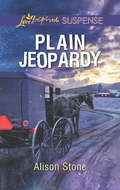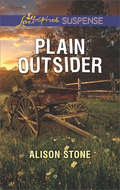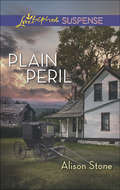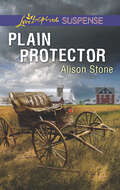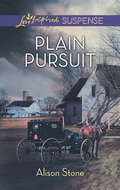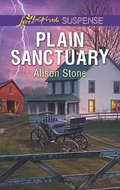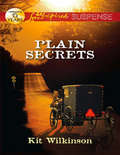- Table View
- List View
Place of Science in a World of Values and Facts (Innovations in Science Education and Technology #10)
by Loucas G. ChristophorouThis is an engrossing book. It is also an unusual book: it is written by a scientist who is quite willing to talk about the softer side of life, about things such as love and respect and responsibility, and to try and position them in the context of his science. He is also willing to talk about religion, the manner in which it relates to science and science to it, and to attempt reconciliation of both. He sets himself a tough task, to tread the narrow path between the maudlin and the severely sober. In this, he is eminently successful. He is successful not because he aims at any grand synthesis, but because he has chosen the more modest path of simply laying out the cards on the table. This work is also unusual for another reason. The majority of books that attempt to explain science to a lay public, that try to describe its workings, its raison d'être, its hidden contents, its societal impact, its implications for our future, etc. , are written by theorists. This is hardly surprising. The theoretician, after all, is expected to think deeply, to be the great unifier, to be concernedwith meaning. Very few books about science are written by scientists, ones who spend their time in a working experimental laboratory. This is such a book. And because it is, it is also a very different book.
Place, Spirituality, and Well-Being: A Global and Multidisciplinary Approach (Religion, Spirituality and Health: A Social Scientific Approach #7)
by Victor Counted Haywantee Ramkissoon Laura E. Captari Richard G. CowdenThis book synthesizes perspectives on how ‘place’ is deeply intertwined with our spirituality and well-being. Split into three sections, this book brings together contributions from global scholars across a range of disciplines to unravel how the personal, social, and cultural spheres of place shape our spiritual experiences and overall well-being. It is an essential read for those interested in enriching their knowledge of the linkages between place, spirituality, and well-being, while also providing a foundation for future research on place and its intersections with both spirituality and well-being.
A Place to Belong (Redemption River #3)
by Linda GoodnightFaith and warm memories have helped widow Kitty Wainwright endure the loss of her husband.
Placemaking and Cultural Landscapes (Advances in Geographical and Environmental Sciences)
by Pravin S. Rana Olimpia Niglio Rana P. B. SinghPlacemaking and cultural landscapes are worldwide multidisciplinary global concerns that cover many points of view of the common impacts of socio-economic cultural and rights jurisprudence planning, wellbeing and related advancements. Concerned with the complex interactions between the development and environment of those factors, it is important to seek ways, paths and implications for framing sustainability in all social activities. This book is mostly based on the 10th ACLA – Asian Cultural Landscape Association International Webinar Symposium that took place during September 26–27, 2020, in the Banaras Hindu University, Varanasi, India. It examines contemporary social–cultural issues in the context of the United Nations Sustainable Development Goals (UN-SDGs) and associated cultural and sacred landscapes. There, the emphasis is on awakening deeper cultural sensitivity in harmonizing the world and the role of society and spiritual systems, drawing upon multi-disciplinary and cross-cultural interfaces—all within the scope of the future of the earth. The book’s chapters add a new dimension of cultural understanding in the broad domain of emerging human geoscience, considered as key policy science for contributing towards sustainability and survivability science together with future earth initiatives.
Places in Motion: The Fluid Identities of Temples, Images, and Pilgrims
by Jacob N. KinnardJacob Kinnard offers an in-depth examination of the complex dynamics of religiously charged places. Focusing on several important shared and contested pilgrimage places-Ground Zero and Devils Tower in the United States, Ayodhya and Bodhgaya in India, Karbala in Iraq-he poses a number of crucial questions. What and who has made these sites important, and why? How are they shared, and how and why are they contested? What is at stake in their contestation? How are the particular identities of place and space established? How are individual and collective identity intertwined with space and place? Challenging long-accepted, clean divisions of the religious world, Kinnard explores specific instances of the vibrant messiness of religious practice, the multivocality of religious objects, the fluid and hybrid dynamics of religious places, and the shifting and tangled identities of religious actors. He contends that sacred space is a constructed idea: places are not sacred in and of themselves, but are sacred because we make them sacred. As such, they are in perpetual motion, transforming themselves from moment to moment and generation to generation. Places in Motion moves comfortably across and between a variety of historical and cultural settings as well as academic disciplines, providing a deft and sensitive approach to the topic of sacred places, with awareness of political, economic, and social realities as these exist in relation to questions of identity. It is a lively and much needed critical advance in analytical reflections on sacred space and pilgrimage.
Places in Motion: The Fluid Identities of Temples, Images, and Pilgrims
by Jacob N. KinnardJacob Kinnard offers an in-depth examination of the complex dynamics of religiously charged places. Focusing on several important shared and contested pilgrimage places-Ground Zero and Devils Tower in the United States, Ayodhya and Bodhgaya in India, Karbala in Iraq-he poses a number of crucial questions. What and who has made these sites important, and why? How are they shared, and how and why are they contested? What is at stake in their contestation? How are the particular identities of place and space established? How are individual and collective identity intertwined with space and place? Challenging long-accepted, clean divisions of the religious world, Kinnard explores specific instances of the vibrant messiness of religious practice, the multivocality of religious objects, the fluid and hybrid dynamics of religious places, and the shifting and tangled identities of religious actors. He contends that sacred space is a constructed idea: places are not sacred in and of themselves, but are sacred because we make them sacred. As such, they are in perpetual motion, transforming themselves from moment to moment and generation to generation. Places in Motion moves comfortably across and between a variety of historical and cultural settings as well as academic disciplines, providing a deft and sensitive approach to the topic of sacred places, with awareness of political, economic, and social realities as these exist in relation to questions of identity. It is a lively and much needed critical advance in analytical reflections on sacred space and pilgrimage.
Places of Faith: A Road Trip across America's Religious Landscape
by Roger Finke Christopher P. ScheitleLavishly illustrated with over 100 color photographs, Places of Faith takes readers on a fascinating religious road trip. Christopher Scheitle and Roger Finke have crisscrossed America, visiting churches in small towns and rural areas, as well as the mega-churches, storefronts, synagogues, Islamic centers, Eastern temples, and other places of faith in major cities. Each stop on their tour provides an opportunity to introduce a particular current of American religion. Memphis serves as a window into the Black Church, a visit to Colorado Springs provides insight into evangelicalism, and a stop in Detroit sheds light on American Muslims. Readers visit Hare Krishnas in San Francisco, the Amish in central Pennsylvania, and a "cowboy church" in Amarillo, Texas. As the authors journey across the country, they retell unique religious histories and touch on local religious profiles and trends. They draw from conversations they had with pastors, imams, bishops, priests, and monks, along with ordinary believers of all kinds. Most of all, they tell the reader what they saw and heard, putting a human face on America's astounding religious diversity.
Places of Faith: A Road Trip across America's Religious Landscape
by Christopher P. Scheitle Roger FinkeLavishly illustrated with over 100 color photographs, Places of Faith takes readers on a fascinating religious road trip. Christopher Scheitle and Roger Finke have crisscrossed America, visiting churches in small towns and rural areas, as well as the mega-churches, storefronts, synagogues, Islamic centers, Eastern temples, and other places of faith in major cities. Each stop on their tour provides an opportunity to introduce a particular current of American religion. Memphis serves as a window into the Black Church, a visit to Colorado Springs provides insight into evangelicalism, and a stop in Detroit sheds light on American Muslims. Readers visit Hare Krishnas in San Francisco, the Amish in central Pennsylvania, and a "cowboy church" in Amarillo, Texas. As the authors journey across the country, they retell unique religious histories and touch on local religious profiles and trends. They draw from conversations they had with pastors, imams, bishops, priests, and monks, along with ordinary believers of all kinds. Most of all, they tell the reader what they saw and heard, putting a human face on America's astounding religious diversity.
Places of Worship (Ways Into RE)
by Louise SpilsburyA friendly and very visual introduction to the key principles and practices of the world`s six main religious faiths.
A Plague on Both Their Houses: Liberal vs. Conservative Christians and the Divorce of the Episcopal Church USA
by Christopher Craig BrittainChristopher Craig Brittain offers a wide-ranging examination of specific events within The Episcopal Church (TEC) by drawing upon an analysis of theological debates within the church, field interviews in church congregations, and sociological literature on church conflict. The discussion demonstrates that interpretations describing the situation in TEC as a culture war between liberals and conservatives are deeply flawed. Moreover, the book shows that the splits that are occurring within the national church are not so much schisms in the technical sociological sense, but are more accurately described as a familial divorce, with all the ongoing messy entwinement that this term evokes. The interpretation of the dispute offered by the book also counters prominent accounts offered by leaders within The Episcopal Church. The Presiding Bishop, Katharine Jefferts-Schori, has portrayed some opponents of her theological positions and her approach to ethical issues as being 'fundamentalist', while other 'Progressives' liken their opponents to the Tea Party movement.
A Plague on Both Their Houses: Liberal vs. Conservative Christians and the Divorce of the Episcopal Church USA
by Christopher Craig BrittainChristopher Craig Brittain offers a wide-ranging examination of specific events within The Episcopal Church (TEC) by drawing upon an analysis of theological debates within the church, field interviews in church congregations, and sociological literature on church conflict. The discussion demonstrates that interpretations describing the situation in TEC as a culture war between liberals and conservatives are deeply flawed. Moreover, the book shows that the splits that are occurring within the national church are not so much schisms in the technical sociological sense, but are more accurately described as a familial divorce, with all the ongoing messy entwinement that this term evokes. The interpretation of the dispute offered by the book also counters prominent accounts offered by leaders within The Episcopal Church. The Presiding Bishop, Katharine Jefferts-Schori, has portrayed some opponents of her theological positions and her approach to ethical issues as being 'fundamentalist', while other 'Progressives' liken their opponents to the Tea Party movement.
Plain Admirer (Brides of Amish Country #9)
by Patricia DavidsLove Is Only A Letter Away So what if Joann Yoder’s Amish community deems her a spinster? She’s content to stay single. In the meantime, she’s working hard to finally buy her dream house. So it’s problematic when she’s fired from her job to make room for the nephew’s owner, Roman Weaver.
Plain Cover-Up: Silent Sabotage Plain Cover-up Ranch Refuge (Mills And Boon Love Inspired Suspense Ser.)
by Alison StoneSECOND CHANCE PROTECTOR
Plain Diversity: Amish Cultures and Identities (Young Center Books in Anabaptist and Pietist Studies)
by Steven M. Nolt Thomas J. MeyersPlain and simple. American popular culture has embraced a singular image of Amish culture that is immune to the complexities of the modern world: one-room school houses, horses and buggies, sound and simple morals, and unfaltering faith. But these stereotypes dangerously oversimplify a rich and diverse culture.In fact, contemporary Amish settlements represent a mosaic of practice and conviction. In the first book to describe the complexity of Amish cultural identity, Steven M. Nolt and Thomas J. Meyers explore the interaction of migration history, church discipline, and ethnicity in the community life of nineteen Amish settlements in Indiana. Their extensive field research reveals the factors that influence the distinct and differing Amish identities found in each settlement and how those factors relate to the broad spectrum of Amish settlements throughout North America. Nolt and Meyers find Amish children who attend public schools, Amish household heads who work at luxury mobile home factories, and Amish women who prefer a Wal-Mart shopping cart to a quilting frame. Challenging the plain and simple view of Amish identity, this study raises the intriguing question of how such a diverse people successfully share a common identity in the absence of uniformity.
Plain Jeopardy: A Man For Honor Plain Jeopardy (Mills And Boon Love Inspired Suspense Ser.)
by Alison StoneAMISH COUNTRY SECRETS
Plain Outsider: The Amish Widow's New Love Plain Outsider (Mills And Boon Love Inspired Suspense Ser.)
by Alison StoneCaught between her Amish past and Englisch future…and in the crosshairs of danger!
Plain Peril: Fugitive Trackdown Plain Peril Manhunt (Mills And Boon Love Inspired Suspense Ser.)
by Alison StoneKILLER IN AMISH COUNTRYD
Plain Protector: The Protector's Mission Plain Threats Easy Prey (Mills And Boon Love Inspired Suspense Ser. #4)
by Alison StoneAMISH COUNTRY REFUGE When an unknown assailant attacks Sarah Gardner shortly after she moves to Apple Creek, she doesn’t know which of her fears has come true. Is someone trying to tell her that meddling strangers aren’t welcome in this tight-knit Amish community, or has her abusive ex-boyfriend found her?
Plain Pursuit: Primary Suspect Plain Outsider Fugitive Pursuit (Mills And Boon Love Inspired Suspense Ser.)
by Alison StoneDANGER IN AMISH COUNTRY When her brother is killed in a small Amish town, Anna Quinn discovers she’s an unwelcome outsider. But the FBI agent investigating the case is right at home—because Eli Miller was born and raised in Apple Creek’s Plain community.
Plain Sanctuary: Mistaken Identity Plain Sanctuary Security Detail (Mills And Boon Love Inspired Suspense Ser.)
by Alison StoneAMISH COUNTRY DANGER
Plain Secrets (Mills And Boon Love Inspired Suspense Ser.)
by Kit WilkinsonRETURN OF THE PRODIGAL “ENGLISHER”
Plain Target: Guardian False Security Plain Target (Amish Country Justice #1)
by Dana R. LynnSANCTUARY IN AMISH COUNTRY



